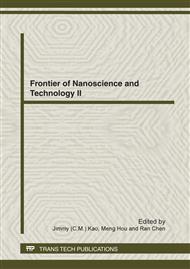p.91
p.95
p.99
p.103
p.107
p.113
p.117
p.121
p.126
Calcium Ion Treatment Behavior of Silk Fibroin/Sodium Alginate Scaffolds
Abstract:
The silk fibroin/sodium alginate scaffolds were prepared using lyophilization method. And then, the blend scaffolds were treated with calcium ions. The morphology of the blend scaffolds exhibited a thin layer structure before calcium ions treatment, and much more rod-like structure appeared at the layer surface with adding the increase content of sodium alginate in the blend scaffolds. After calcium ions treatment, much more rod-like structure disappeared after adding 30% sodium alginate or more in the blend scaffolds. Wide angle X-ray diffraction and Fourier transform infrared analysis results confirmed the crystal structure of silk fibroin was not influenced by adding the different content of sodium alginate, exhibiting the silk I and silk II structure co-existed in the blend scaffolds. And the same time, the average mass loss value of the blend scaffolds was higher than the pure silk fibroin scaffold, reaching 9.884%, 11.2%, and 8.626%, respectively, when the blend scaffolds contained 10%, 30%, and 50% sodium alginate, respectively. Thus, the silk fibroin/sodium alginate scaffolds should be a useful biomaterial applicable for a wide range of tissue engineering.
Info:
Periodical:
Pages:
107-112
Citation:
Online since:
June 2012
Authors:
Keywords:
Price:
Сopyright:
© 2012 Trans Tech Publications Ltd. All Rights Reserved
Share:
Citation:


